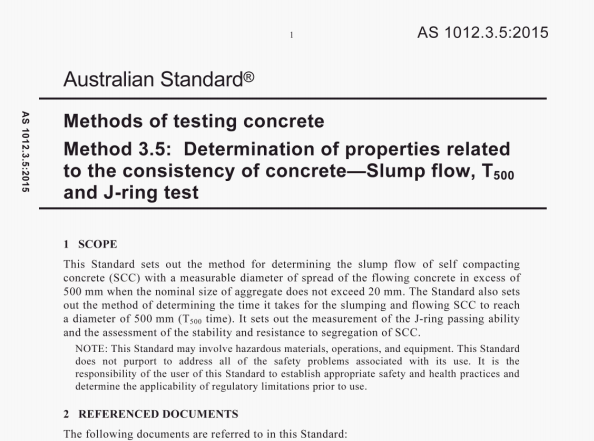AS 1012.3.5:2015 pdf – Methods of testing concrete Method 3.5: Determination of properties related to the consistency of concrete-Slump flow,T500 and J-ring test.
(f) Place the slump cone carefully on a stable and levelled base plate, which is free from vibration or shock. Hold the slump cone firmly in place. Position the slump cone with the larger opening coincident with the 200 mm circle on the base plate (see Figure 2). Maintain the slump cone in position while it is being filled, ensuring that no concrete can leak from under the cone (see Figure 3).
(g) Ensure that the procedure from the start of filling to the removal of the slump cone [i.e. Steps (h) to (I)], is carried out without interruption and is completed within an elapsed time of 2.5 mm.
(h) Fill the slump cone by pouring in concrete continuously until it reaches the top edge without vibration or tamping. Over-till the slump cone slightly and if a detachable conical collar or funnel is used (see Note) then remove this.
NOTE: A detachable conical collar or funnel may be used to facilitate tilling the slump cone. The collar or funnel should not penetrate thc slump cone by more than 5 mm.
(i) Strike of the surface of the concrete level with the top of the slump cone by means of a screeding and rolling motion of the rod so that the slump cone is filled exactly. Quickly remove any concrete overflow from around the base of the mould to preclude interference with the movement of the flowing concrete and while doing so avoiding any movement or vibration of the slump cone.
(j) Maintain a firm downward pressure at all times until the slump cone is removed. Immediately remove the slump cone from the concrete by raising it slowly and carefully in a vertical direction, allowing the concrete to subside as it flows concentrically along the test surface. Complete the operation of raising the slump cone in 3 ±1 s in a steady vertical lift without causing any tilting, lateral or torsional movement of the slump cone and without interfering with the flow of the concrete.
(k) lithe T5 time (flow rate) is required, start the stopwatch immediately the slump cone ceases to be in contact with the base plate and record the time to the nearest 0.1 second, for the spreading concrete to reach the marked 500mm (see Figure 2) circle at any point.
NOTE: It is possible for the stopwatch to be operated by the concrete tester or another person under the concrete tester’s supervision.
(I) Wait for the concrete to stop flowing and without disturbing the base plate or concrete measure and record the largest diameter (d1) of the resulting circular spread of concrete to the nearest 5 mm, Measure and record a second diameter (d2) of the circular spread at an angle approximately perpendicular to the first measured diameter (d1), to the nearest 5 mm. [See Figure 4(a).]
If the measurement of the two diameters differs by more than 50 mm, the test is invalid and shall be repeated.
AS 1012.3.5:2015 pdf – Methods of testing concrete Method 3.5: Determination of properties related to the consistency of concrete-Slump flow,T500 and J-ring test
